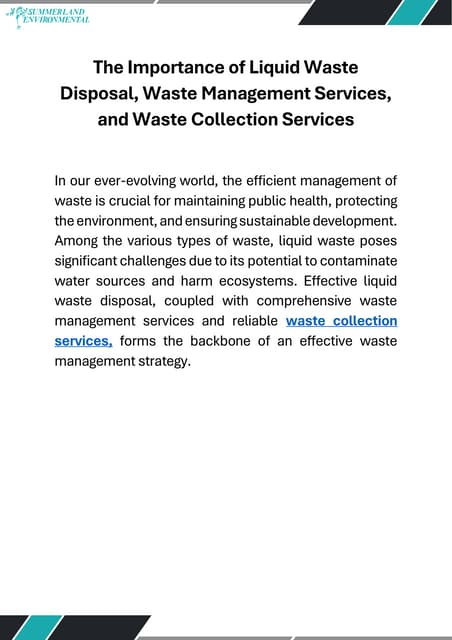The Only Guide for Reclaim Waste
The Only Guide for Reclaim Waste
Blog Article
5 Easy Facts About Reclaim Waste Shown
Table of ContentsUnknown Facts About Reclaim WasteGetting The Reclaim Waste To WorkFacts About Reclaim Waste UncoveredThe Of Reclaim WasteAll About Reclaim Waste
Residential sewage waste refers to the waste and items from a household septic tank. The correct administration and disposal of residential sewer waste require fluid waste to be moved to a sewage treatment plant where the correct approaches and equipment are applied to detoxify and dispose of waste.
Business waste usually includes prospective hazards, such as flammable materials or a blend of fluid and strong waste products, and calls for an advanced and comprehensive disposal process. The disposal of commercial waste generally includes the filtration of waste prior to transportation to make certain risk-free and proper disposal. Hazardous waste is created from byproducts and runoff of commercial procedures and manufacturing.
This type of waste can not use the exact same sewage administration transportation or processes as septic or commercial fluids. The commercial waste management process calls for the inspection and testing of fluid waste prior to it undertakes the disposal procedure (liquid waste removal melbourne). Overflow waste is the liquid waste that comes from runoff and excess stormwater in extremely inhabited areas or cities
Runoff waste can trigger contamination and flooding if not taken care of effectively. Discover more concerning drain cleansing and waste administration. Ensuring proper waste monitoring can avoid catastrophes and decrease environmental damage. Both individuals in residential settings and experts in commercial or manufacturing sectors can take advantage of understanding the processes and regulations of fluid waste management.
Reclaim Waste Things To Know Before You Get This
Contact PROS Services today to find out about our waste management and disposal solutions and the proper means to look after the liquid waste you produce.
(https://www.metal-archives.com/users/reclaimwaste1)This supposed 'wastewater' is not only an essential source however, after treatment, will be released to our land, waterways or the ocean. Made use of water from toilets, showers, baths, kitchen sinks, laundries and industrial processes is recognized as wastewater.

water made use of to cool equipment or clean plant and tools). Stormwater, a type of wastewater, is runoff that moves from agricultural and metropolitan locations such as roofings, parks, yards, roads, courses and gutters into stormwater drains pipes, after rain. Stormwater streams without treatment straight to neighborhood creeks or rivers, eventually getting to the sea.
The Only Guide to Reclaim Waste
In Queensland, most wastewater is treated at sewage treatment plants. Wastewater is transported from residential or industrial sites with a system of drains and pump terminals, referred to as sewage reticulation, to a sewer therapy plant. Neighborhood federal governments construct, maintain and run most sewer therapy plants. Operators are accredited under the Environmental Protection Act 1994 to discharge cured wastewater at an appropriate ecological criterion right into rivers.
The Department of Natural Resources advises city governments about managing, operating and maintaining sewage systems and therapy plants. In unsewered locations, city governments might call for owners to mount specific or house sewer therapy systems to deal with residential wastewater from commodes, cooking areas, washrooms and laundries. The Department of Natural Resources authorizes the usage of home systems when they are shown to be efficient.
In some brand-new class, treatment of some stormwater to eliminate litter, sand and crushed rock has begun making use of gross contaminant catches. Wastewater treatment takes place in four phases: Removes solid issue.
Wastewater then moves into huge tanks where solids clear up and are removed as sludge. Oil and residue are skimmed from the surface. Uses tiny living microorganisms called micro-organisms to break down and get rid of remaining liquified wastes and great particles. Micro-organisms and wastes are included in the sludge. Removes nitrogen and phosphorus nutrients that might cause algal blossoms in our waterways and endanger marine life.
The Best Strategy To Use For Reclaim Waste
Nutrient elimination is not offered at all sewer treatment plants because it requires expensive specialised tools. Clear fluid effluent generated after therapy might still include disease-causing micro-organisms - industrial wastewater treatment.

This usually means wastewater needs to be dealt with or pollutants eliminated before it can be released to waterways. Most wastewater flows right into the sewerage system. Under the Act, city governments provide approvals and licences for eco appropriate activities (Periods) including wastewater releases that might have a neighborhood effect. The department administers authorizations and licences to ERAs entailing wastewater launches that may have a regional or statewide impact.
The Of Reclaim Waste
Otherwise, samples are considered laboratory analysis. Often numerous examinations are required to establish the degrees of each of the various contaminants such look at more info as oils, heavy steels and chemicals in water. Monitoring gives factual info concerning water top quality and can validate that licence problems are being satisfied. The information gotten with monitoring supplies the basis for making water high quality choices.
Report this page